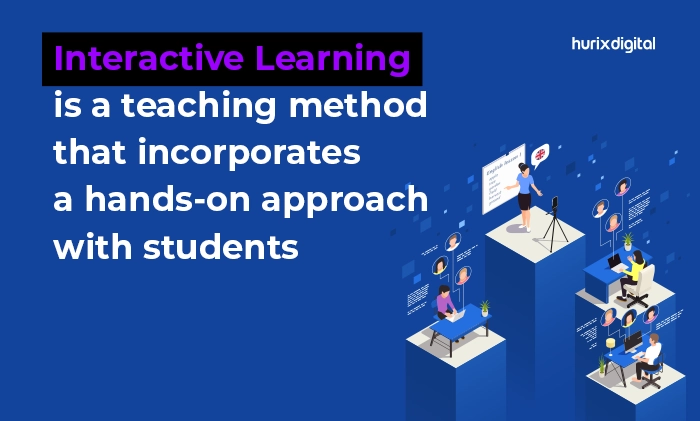Role of Technology in Promoting Interactive Learning
The role of technology in promoting interactive learning has been massive and thus, K-12 educational institutions are readily embracing tech-driven learning. Digitization has revolutionized the existing traditional education system and added to the success of K-12 learning.
This blog will discuss how technology has led to improvements in the education system and inculcated interactive learning.
Table of Contents:
- Importance of Interactive Learning
- Role of Technology in Promoting Interactive Learning
1. Enhancing Student Engagement
2. Promote Collaborative Learning Regardless of Location
3. Encourage Active Student Participation
4. Provide Interactive Assessment Solutions
5. Provide Updated Information to Students
6. Promote Self-Paced Learning - Conclusion
Importance of Interactive Learning

Interactive learning involves flexible and open-ended classrooms and is facilitated through student-to-student collaboration, freedom of choice, and adaptive course correction. Following this method of learning brings a more hands-on approach to educating students.
The use of game and video-based learning materials keeps learners motivated and engaged. It improves their self-awareness, decision-making, emotion management, social awareness, and relationship-building skills.
Thus, students tend to stay goal-oriented, be prepared to face potential challenges, and have the capability to not engage in delinquent behavior due to negative peer pressure.
Collaborative learning promotes students’ ability to engage in group decision-making, maintain interpersonal relations, involve themselves in teamwork, and amicably resolve conflict. Interactive learning helps students internalize what they have learned and apply them in real life.
Digitization has widened the scope for teachers, and they no longer have to stick to traditional, defined, restricted curricula and methods of teaching. The devices and technology used in interactive learning, though costly, are a one-time investment that will optimize time spent on teaching and learning and are also environment-friendly.
Role of Technology in Promoting Interactive Learning
1. Enhancing Student Engagement
Keeping students engaged in learning is the first key aspect of lesson planning. Irrespective of whether students are working alone or collaboratively, utilizing technology will promote student engagement.
Introducing technology in learning reduces repetitive learning. Teachers can introduce new subjects, techniques, and projects to create an engaging learning environment. Technology can be used to plan lessons in a way that would help meet the needs of all students.
This will keep students interested and will prevent them from getting bored with the learning process. Incorporating technology in learning will also increase motivation, interest, and self-regulation and provide students with a sense of community, accessibility, and support.
2. Promote Collaborative Learning Regardless of Location
Using technology to create and deliver learning solutions opens possibilities to online interactions such as text messages, video conferencing, and interactive projects. It makes teaching and learning more meaningful and fun.
Effective collaboration is necessary to maintain motivation among students. The collaboration between students and teachers instills a sense of community and shared learning. This will ensure that students stay motivated.
Effectively integrating technology into subjects will enhance the roles of teachers into advisers, coaches, and guides. Using technological advancements, teachers can guide students to collaborate.
This will help students stay motivated and imbibe skills of leadership and teamwork. Especially during COVID-19, technology has helped teachers and students in different geographical locations collaborate easily and effectively.
3. Encourage Active Student Participation
Using technology in learning will improve student participation, unlike in traditional teaching. It is important to provide students with a learning community to participate actively and learn collaboratively.
Teachers can modify lessons flexibly so that the active participation of all students can be ensured and encouraged. They can schedule and form separate groups and individual lessons when necessary.
Personalized learning content can be shared with students to make learning more interesting and self-oriented for each student.
Students actively participating in learning gain more skills to process information, explore the meaning of what is taught to them, and demonstrate what they’ve learned, individually and collaboratively.
4. Provide Interactive Assessment Solutions
Assessments help evaluate students regarding what they have learned. Interactive assessments may be in the form of online quizzes, essay questions, online interviews, polls, dialogue simulations, game activities, peer evaluations, reviews, etc.
They inculcate critical thinking and practical application, demonstrate proficiency, and improve communication skills. At the same time, assessments are fun and innovative.
5. Provide Updated Information to Students
Updating academic textbooks and printed materials is a long and uneconomical process. Often, they contain obsolete information. However, online information is updated continuously and is dynamic. New information travels fast online. It is also incorporated quickly into education.
Constant updating of information is extremely important in modern science, contemporary history, politics, and economics. It helps with the smooth transition of students into higher education and joining the workforce.
Also Read: eLearning Trends for K-12 Education in 2022
6. Promote Self-Paced Learning
Traditional classrooms might not suit every student when it comes to their progress in learning. Not all students might be comfortable and have continued interest in learning from just one source of information.
Interactive learning offers diverse sources with updated features and provides a vast amount of modern knowledge. Interactive learning allows students to slow down and repeat lessons and concepts when they find difficulty in learning something.
It also offers students the freedom to understand more advanced concepts when they seek to progress faster. Thus, students can learn at their own pace with interactive learning technologies.
Conclusion
Technology is a powerful tool for education. It has greatly enriched the work of teachers and has improved the quality of education by offering a more interactive and engaging approach to learning.
Using technology in learning offers students new experiences and opens doors to self-discovery. If not for technology, students would have been forced to discontinue education for almost more than two years.
Given the benefits of e-learning, it might very well be the new normal of education. However, it would be upon schools, students, and parents to help navigate this new course to reap the best benefits out of it. Reach out to us to know more about our services.

Senior Vice President – APAC
A Business Development professional with >20 years of experience with strong capability to sell new solutions and develop new markets from scratch. New Market Entry Specialist with experience of working in two of the largest emerging markets – China & India. Also covered other key markets in APAC & ME. Exceptional experience of conceptualizing, ideating and selling new learning technologies like VR AR, etc. across multiple industry verticals.









